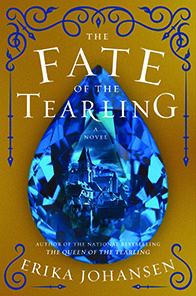 The Fate of the Tearling
The Fate of the Tearling
Erika Johansen
Harper
Release Date: November 29, 2016
ISBN 978-0-0622-9042-7
In 2014, Erika Johansen debuted a new fantasy trilogy with The Queen of the Tearling. It was astonishingly well written and full of promise, generating a huge amount of buzz. Even though only the first book in the series, it was quickly optioned for a set of movies to be produced by David Heyman (who has an impressive résumé, including all the Harry Potter movies, plus other little films like Gravity and Fantastic Beasts and Where to Find Them) as well as Emma Watson, who would not only serve as executive producer, but also play the title role of Kelsea Glynn. I was totally on board for all of it.
But then the second book of the trilogy came out in 2015,The Invasion of the Tearling. While many continued to rally staunchly behind the series, I was so unimpressed with this second installment that I opted out of reviewing it. The book felt schizophrenic, jumping from the near-future-reality to far-future-fantasy with little to link the two together, stylistically or thematically. Gaping questions were not addressed head on, perhaps to lend a sense of mystery; for me it simply came off as confusing. Conversely, issues that were idiosyncratic in the first book became huge discrepancies in the second. But my main objection was that the action was simplistic and contrived, coming mighty close to creepy in how much it leaned on the misery of enslaved women and children in order to allow for brutal shifts in morality.
So when the concluding book in the trilogy was released a few months ago, the question for me was, would it be a continuation of the flawed second book, or return to the glory of The Queen of the Tearling?
I am happy to report that while The Fate of the Tearling still falls short of the promise of the first volume of the trilogy, it not only is a much stronger book than The Invasion of the Tearling, but even manages to redeem that second volume somewhat, in that a few of the most egregious of the unaddressed questions are finally and satisfactorily answered in a way that even lends a bit of credence to the ambiguities that at the time felt quite frustrating.
The gist of the trilogy is that unassuming Kelsea Glynn, who has been sequestered away for most of her life in a cottage in the woods, is, in reality, the heir of the royal Tearling line. The country of Tear was established by a group of colonists, led by visionary William Tear, who had survived a harrowing “Crossing” – from another place and another time shrouded in mystery. The initial colony, known simply as “the Town,” was meant to be a utopia devoid of class hierarchy, religious arrogance or social vanity, but by the time Kelsea is plucked from obscurity, it has grown to a sprawling land in conflict with neighboring Mortmesne (a dark state led by the cruel Red Queen), and in conflict with itself after a line of inept leaders, the eruption of an accepted layer of debauchery, and the growing influence of a corrupt priesthood.
Kelsea must not only navigate the normal uncertainties of becoming a young woman but also the unique challenges of ruling a country in turmoil, with new threats appearing with every action she undertakes, all while balancing the pull of royal magics that appear temptingly fair but whose use comes at a huge cost.
It’s a fanciful and complex story line that ultimately satisfies in The Fate of the Tearling. Not merely a book that ties up loose ends, in this final volume of the series we get new characters and new takes on old characters, new situations, and new insights that put past actions and reactions in a totally revamped light. While we never return to the pre-Crossing world that was somewhat unsettling in The Invasion of the Tearling, we are given access to a pivotal time in Tear’s history that, while harboring factors that are frustratingly convenient, nevertheless gives badly needed cohesion to long running questions of the “how did we get here?” ilk. And, to be honest, while The Fate of the Tearling was not given entirely to tying up loose ends, there were quite a few to address. Author Erika Johansen does an admirable job of revisiting them all, without it seeming like she’s rushing or manufacturing action merely to tick bullet points off her list.
Ultimately, The Fate of the Tearling and the entire Tearling trilogy is worth reading, especially if you love complex fantasy and appreciate a strong female lead who manages to keep from being mired in romantic entanglements while attempting to save the world. (There is a bit of romance in the Tear series, but it’s not a focus of any of the books, thankfully; that would have been one target too many.) But, to adaptively borrow from Ms. Johansen’s final acknowledgement, if you prefer your fantasy tales to be delivered neatly in a beautiful expositional package, then you may want to hedge your bets and wait for the movies,instead.
~ Sharon Browning

